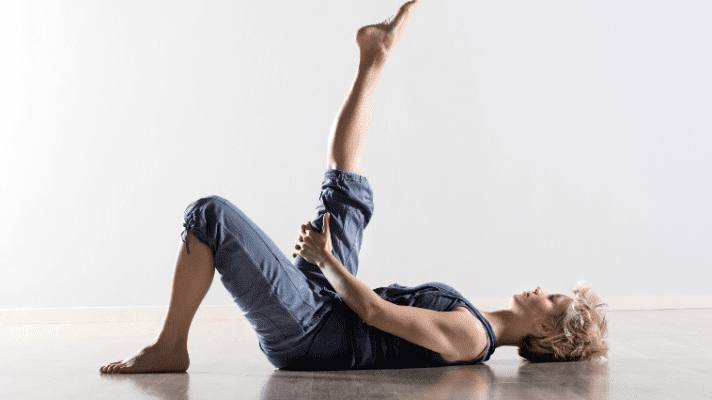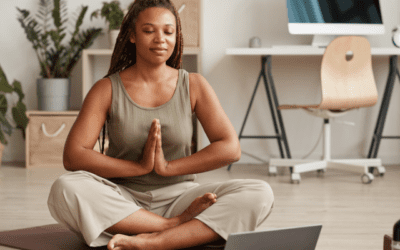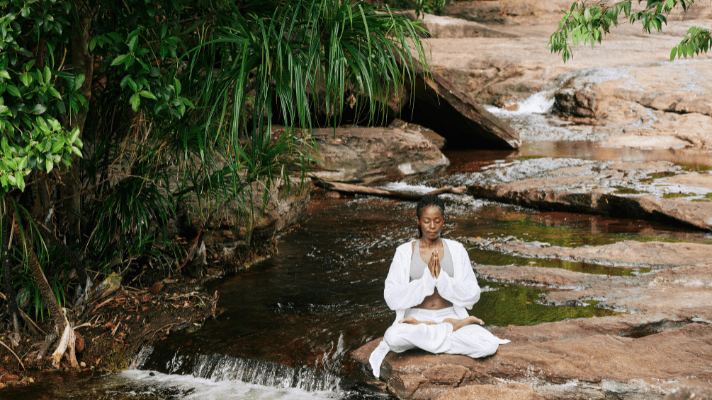Introduction to Somatic Stretching: Definition & Benefits
The main principle behind somatic stretching is that the nervous system controls our muscles. Increasing our body’s awareness and re-educating the nervous system can improve our flexibility and range of motion more effectively.
During somatic stretching exercises, individuals are encouraged to tune into their bodies and notice any areas of tension or restriction. The goal is to release these areas through slow, controlled movements and conscious relaxation techniques. By moving with awareness and avoiding force or pushing beyond limits, somatic stretching aims to retrain the nervous system to allow for more efficient, effortless movement.
How Somatic Stretching Works – Technique, Postures & Movements
Somatic stretching combines conscious movement, relaxation techniques, and body awareness to improve flexibility, release tension, and enhance overall movement patterns. The method focuses on retraining the nervous system for more efficient and effortless movement.
Here are some critical elements of somatic stretching:
1. Mindful Movement: Somatic stretching emphasizes slow, controlled movements performed with mindfulness and awareness. It’s essential to tune into your body and pay attention to how each movement feels.
2. Sensory Feedback: During somatic stretching, you actively seek feedback from your body’s sensations. This involves noticing areas of tension, discomfort, or restriction and using that information to guide your movements.
3. Gentle Exploration: Instead of forcing stretches or pushing beyond limits, somatic stretching encourages gentle exploration. You move within a comfortable range of motion, gradually increasing it as your body allows.
4. Pandiculation: A unique aspect of somatic stretching is pandiculation. This three-step process involves gently contracting, releasing, and relaxing muscles. Pandiculation helps reset muscle length and releases chronic tensions held in the body.
5. Whole-Body Integration: Somatic stretching focuses on the interconnectedness of the body and promotes whole-body movement rather than isolating specific muscles or joints. It aims to improve overall movement patterns and coordination.
6. Relaxation Techniques: Alongside movement, somatic stretching incorporates relaxation techniques such as deep breathing, visualization, and conscious relaxation. These techniques help release tension stored in the body and promote a sense of calmness.
Different Types of Somatic Stretching Techniques & Their Benefits
Here are a few examples of various somatic stretching techniques:
1. PNF (Proprioceptive Neuromuscular Facilitation): PNF stretching involves a combination of contracting and relaxing specific muscle groups while stretching them. This technique engages the proprioceptors, sensory receptors in the muscles and tendons, to promote increased flexibility and range of motion.
2. Active Stretching: Active stretching focuses on using your muscles to move into a stretched position without external assistance. It involves gently contracting the opposing muscles while lengthening the target muscles. Active stretching helps improve muscle coordination, balance, and overall flexibility.
3. Passive Stretching: Passive stretching involves using external assistance, such as a partner, gravity, or props, to help achieve a deeper stretch. The individual relaxes their muscles while the external force gradually moves them into a stretched position. Passive stretching can help increase flexibility and range of motion.
4. Dynamic Stretching: Dynamic stretching involves performing controlled, repetitive movements that mimic the motions of a specific activity or sport, often used as part of a warm-up routine to increase blood flow, loosen muscles, and enhance performance.
5. Self-Myofascial Release: Self-myofascial release utilizes tools such as foam rollers or massage balls to apply pressure to specific points on the body. By releasing tension and adhesions in the fascia, this technique can improve mobility, reduce muscle soreness, and enhance overall movement patterns.
The benefits of somatic stretching techniques include the following:
– Improved Flexibility: Somatic stretching techniques can help increase the length and elasticity of muscles, tendons, and other soft tissues, improving flexibility and range of motion.
– Increased Body Awareness: Somatic stretching involves mindful movement and sensory feedback, which promotes a deeper connection with the body. This increased awareness can help identify areas of tension or imbalance and address them effectively.
– Reduced Muscle Tension: Somatic stretching techniques emphasize relaxation and release of muscle tension. It’s possible to alleviate chronic tightness and discomfort by consciously relaxing and lengthening the muscles.
– Enhanced Movement Patterns: By focusing on whole-body movements and coordination, somatic stretching can improve movement patterns and balance. It can also help optimize posture and alignment, reducing the risk of injuries.
– Relaxation and Stress Reduction: Somatic stretching incorporates relaxation techniques, such as deep breathing and conscious relaxation, which can promote a sense of calmness and reduce stress levels.
Practicing Regularly for Optimal Results
Yes, practicing somatic stretching is essential to see optimal results. Consistency in your practice allows your body to gradually adapt and improve flexibility, range of motion, and overall movement patterns.
Here are some tips for incorporating regular somatic stretching into your routine:
1. Set Aside Time: Schedule dedicated time for somatic stretching in your daily or weekly routine. Treat it as a self-care practice and prioritize it like any other crucial daily activity.
2. Start Slowly: Begin with shorter sessions and gradually increase the duration as you become more comfortable. It’s better to start with a few minutes of focused stretching and progressively build up rather than immediately overwhelming yourself with extended sessions.
3. Listen to Your Body: Pay attention to how your body feels during the practice. If you experience pain or discomfort, modify the movements or consult a qualified instructor. Somatic stretching should be gentle and should not cause pain.
4. Focus on Quality, Not Quantity: Rather than rushing through many stretches, focus on the quality of your movements and the depth of your body awareness. Mindfully connect with each time and observe how it feels in your body.
5. Incorporate Variety: Explore different somatic stretching exercises and techniques to keep your practice engaging and enjoyable. Somatic stretching can target different muscle groups and promote overall body balance.
6. Combine with Other Activities: Somatic stretching can complement physical activities such as yoga and pilates to football, hockey, pickleball, and even strength training. Integrating somatic stretching into your warm-up or cool-down routines can also be beneficial.
Conclusion: Overall Benefits of Somatic Stretching
Somatic stretching can be beneficial for people of all ages and fitness levels. It can help improve flexibility, relieve muscle tension and discomfort, enhance posture, and promote better body alignment. Regular practice of somatic stretching can also lead to increased body awareness and a greater sense of overall well-being.
It’s important to note that somatic stretching is not a quick fix or a one-size-fits-all approach. Each person’s body is unique, and progress may vary. We recommend working with a qualified instructor who can guide you through the various movements and help tailor the practice to your needs and abilities. Contact Us if you want to learn more and/ or work with one of our teachers.








